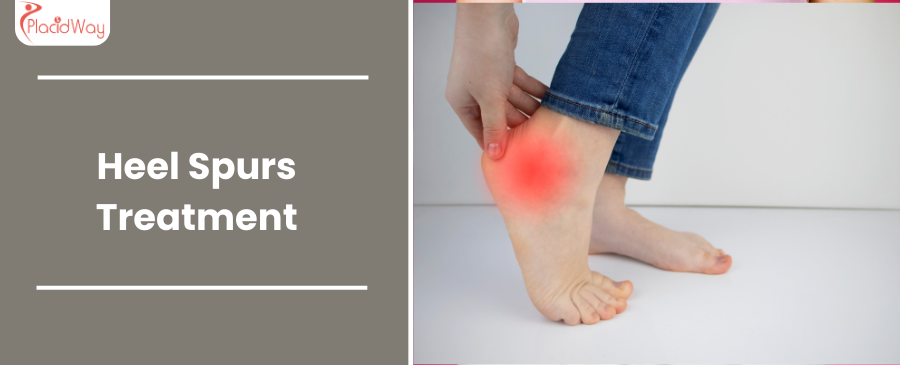
Find Lasting Relief: Expert Heel Spur Treatment Options Worldwide
Are you experiencing debilitating heel pain that makes every step a struggle? You're not alone. Chronic heel pain, often associated with a condition known as a heel spur, affects millions worldwide, significantly impacting quality of life. The constant discomfort can prevent you from enjoying daily activities, exercising, or even walking comfortably.
A heel spur is a calcium deposit that forms on the underside of the heel bone (calcaneus), a bony protrusion that can extend forward. While the spur itself isn't always the direct cause of pain, it frequently develops in conjunction with plantar fasciitis, an inflammation of the thick band of tissue (plantar fascia) connecting your heel bone to your toes. This inflammation is typically what leads to the sharp, stabbing pain many patients report, especially when taking their first steps in the morning or after a period of rest.
If you've been searching for "heel pain relief" or "effective treatment for heel spurs," you know that finding the right solution can be a journey. For those seeking comprehensive care, advanced procedures, or more affordable options, exploring "surgical treatment for heel spurs abroad" has become an increasingly popular choice. Medical tourism offers a unique opportunity to access world-class podiatrists and orthopedic surgeons, state-of-the-art facilities, and often significantly lower costs, all while potentially combining your recovery with a relaxing travel experience.
This guide will deeply explore everything you need to know about heel spurs, from understanding their symptoms and causes to navigating the array of treatment options available, both domestically and internationally. Discover how medical tourism can provide a pathway to lasting relief and help you regain your mobility and quality of life.
What exactly are heel spurs and why do they cause so much pain?
A heel spur, sometimes referred to as a "bone spur on the heel," is essentially a calcium deposit that extends from the underside of your heel bone towards the arch of your foot. Think of it like a small, sharp hook or ledge of bone. While it sounds alarming, it's crucial to understand that the spur itself is not always the direct source of your intense heel pain.
Instead, heel spurs are often a result of chronic tension and strain on the muscles and ligaments of the foot, particularly the plantar fascia. The plantar fascia is a thick, fibrous band of tissue that runs along the bottom of your foot, connecting your heel bone to your toes, and supports the arch of your foot. When this tissue is repeatedly stretched or torn, it can become inflamed and painful—a condition known as plantar fasciitis.
Over time, the body's natural response to this repeated stress and tearing at the attachment point of the plantar fascia to the heel bone is to lay down extra bone tissue, leading to the formation of a heel spur. So, while the spur is present, the discomfort you feel is typically due to the inflammation of the plantar fascia or other soft tissues rubbing against the spur, rather than the spur itself poking you. This is why many people have heel spurs visible on X-rays but experience no pain at all, while others with similar spurs suffer excruciating "pain in bottom of foot near heel."
What are the common symptoms of heel spurs I should look out for?
Recognizing the "heel spur symptoms" is the first step towards seeking effective treatment. The pain associated with heel spurs can range from a dull ache to a sharp, knife-like sensation. Here are the most common signs you might be experiencing a heel spur:
- Sharp, Stabbing Pain: This is the hallmark symptom. Patients often describe it as feeling like a nail is being driven into their heel, particularly with the very first steps out of bed in the morning or after sitting for a long time.
- Pain After Rest: The pain tends to be worst after periods of inactivity, like sleeping or resting, and often lessens after a few minutes of walking as the plantar fascia stretches out. However, it can return later in the day with prolonged activity.
- Dull Ache: While the initial pain is sharp, it can evolve into a persistent, dull ache throughout the day, especially if you're on your feet for extended periods.
- Inflammation and Swelling: The affected area might feel tender to the touch, and you might observe slight swelling or redness around the heel.
- Difficulty Walking: The pain can alter your gait, causing you to limp or avoid putting full weight on the affected heel, which can lead to further problems in your knees, hips, or back.
- Stiffness: A feeling of stiffness in the heel and arch of the foot, particularly after periods of rest.
If you're experiencing these symptoms, especially chronic "pain in the bottom of foot near heel" that doesn't resolve with simple rest, it's essential to consult a healthcare professional for an accurate diagnosis.
What causes heel spurs to develop and who is most at risk?
Understanding the "causes of heel spurs" can help in prevention and effective treatment. Heel spurs don't appear overnight; they are the result of long-term stress and strain on the heel and arch of the foot. Here are the primary factors contributing to their development and who is most susceptible:
- Repetitive Stress and Overuse: This is the most common cause. Activities that involve repeated pounding or stretching of the plantar fascia, such as running, jumping, or prolonged standing on hard surfaces, can lead to micro-tears and inflammation.
- Improper Footwear: Shoes that lack adequate arch support, cushioning, or stability, especially high heels or worn-out athletic shoes, can put excessive strain on the heel and plantar fascia.
- Abnormal Foot Mechanics:
- Flat Feet (Pronation): Feet that roll inward excessively can overstretch the plantar fascia.
- High Arches (Supination): Feet with very high arches may not absorb shock effectively, placing increased stress on the heel.
- Tight Calf Muscles or Achilles Tendon: Tightness in these areas can limit ankle flexibility, putting more strain on the plantar fascia during walking or running.
- Obesity: Excess body weight significantly increases the load on your feet, putting additional stress on the plantar fascia and heel bone.
- Age: As we age, the fatty pad on the bottom of the heel that protects the bone thins out, and the plantar fascia can lose some of its elasticity, making it more prone to injury.
- Certain Occupations: Jobs that require long hours of standing or walking on hard surfaces, such as factory workers, teachers, or healthcare professionals.
- Athletes: Especially runners and those involved in sports that involve jumping or sudden starts and stops, are at higher risk due to the repetitive impact and strain on their feet.
If you fall into any of these "risk factors for heel spurs," taking proactive measures like wearing supportive footwear and stretching can be crucial.
What are the different types of treatments available for heel spurs?
When searching for "heel spur treatment options," you'll find a spectrum of approaches, usually starting with conservative methods before considering surgery. The goal is always to reduce inflammation, alleviate pain, and prevent recurrence.
Non-Surgical (Conservative) Treatments:
Most heel spur pain resolves with non-surgical treatments, which can take several months. These include:
- Rest, Ice, Compression, Elevation (RICE): Reducing activity, applying ice packs, and elevating the foot can help manage acute pain and inflammation.
- Nonsteroidal Anti-Inflammatory Drugs (NSAIDs): Over-the-counter pain relievers like ibuprofen or naproxen can help reduce pain and inflammation.
- Stretching Exercises: Specific stretches for the plantar fascia and Achilles tendon are crucial for increasing flexibility and reducing tension. This is often a cornerstone of "non-surgical heel spur treatment."
- Physical Therapy: A physical therapist can provide guided exercises, massage, and modalities like ultrasound or phonophoresis to promote healing.
- Orthotic Devices: Custom or over-the-counter shoe inserts (orthotics) provide arch support and cushioning, redistributing pressure on the heel.
- Night Splints: Worn during sleep, these keep the plantar fascia and Achilles tendon in a lengthened position, preventing the characteristic morning pain.
- Corticosteroid Injections: Steroid injections can provide temporary pain relief by reducing inflammation directly in the affected area, though repeated injections are often discouraged due to potential side effects.
- Extracorporeal Shockwave Therapy (ESWT): This non-invasive procedure uses high-energy sound waves to stimulate healing in the plantar fascia.
Surgical Treatments:
"Heel spur surgery" is typically considered only after 6 to 12 months of consistent conservative treatment have failed to provide adequate relief. The primary surgical approaches include:
- Plantar Fascia Release: This involves surgically cutting a small portion of the plantar fascia to relieve tension. This is often performed endoscopically (minimally invasive) or through a small open incision.
- Heel Spur Removal: In some cases, the bony spur itself may be removed, particularly if it's large or irritating surrounding soft tissues. This is often done in conjunction with plantar fascia release.
The choice of treatment depends on the severity of your condition, the duration of your pain, and your individual response to conservative measures.
Am I a good candidate for heel spur surgery or other advanced treatments?
Deciding "who needs heel spur surgery" or advanced treatment is a critical discussion between you and your healthcare provider. Surgery is generally a last resort, reserved for specific situations:
- Failure of Conservative Treatment: The primary criterion is that you have undergone at least 6 to 12 months of consistent and varied non-surgical treatments (e.g., physical therapy, orthotics, injections, rest) with little to no significant improvement in your pain. If you've been searching for "when to consider heel spur treatment" beyond home remedies, this is the key indicator.
- Chronic, Debilitating Pain: Your heel pain must be severe enough to significantly interfere with your daily activities, work, exercise, and overall quality of life. If you're constantly limping, unable to stand for long periods, or in constant discomfort despite your efforts, surgery might be considered.
- Accurate Diagnosis: A thorough diagnostic process, usually involving X-rays and sometimes MRI, confirms the presence of a heel spur and rules out other causes of heel pain. The pain should be directly attributable to the plantar fasciitis associated with the spur.
- Good General Health: Candidates should generally be in good health, without conditions that would complicate surgery or recovery (e.g., uncontrolled diabetes, severe circulatory problems, active infections).
- Realistic Expectations: Patients must understand that while surgery can offer significant relief, it's not a guaranteed cure, and a complete recovery can take time.
For advanced non-surgical treatments like ESWT, candidacy is similar: persistent pain after basic conservative care, a confirmed diagnosis, and a desire to avoid surgery while exploring more intensive non-invasive options.
What should I expect during recovery from heel spur treatment?
The "heel spur recovery time" varies significantly depending on whether you undergo conservative or surgical treatment. Patience and adherence to your doctor's instructions are vital for a successful outcome.
Recovery from Non-Surgical Treatment:
- Duration: This is generally a gradual process, spanning several weeks to several months. Improvement is often incremental.
- Activity Modification: You'll likely need to reduce activities that aggravate your heel pain.
- Consistent Regimen: Daily stretching, wearing supportive shoes or orthotics, and applying ice are key. Consistency is more important than intensity.
- Pain Management: Over-the-counter pain relievers or anti-inflammatory medications might be used.
- Physical Therapy: Regular sessions can help restore strength and flexibility.
- Return to Activity: Gradual reintroduction of physical activities is recommended as pain subsides.
Recovery "after heel spur surgery" (Plantar Fascia Release/Spur Removal):
- Immediately After Surgery: You will likely have your foot bandaged and potentially placed in a cast, walking boot, or splint to protect the surgical site.
- Non-Weight Bearing (1-3 weeks): For the initial period, you'll typically need to keep weight off your foot, using crutches or a knee scooter.
- Partial Weight Bearing (3-6 weeks): Gradually, you'll progress to putting some weight on your foot, often still in the protective boot.
- Physical Therapy (Weeks 2-3 onwards): Formal physical therapy will begin to restore range of motion, strength, and proper gait. This is crucial for long-term success.
- Pain and Swelling: Expect some pain, swelling, and bruising, which can be managed with medication and elevation.
- Return to Normal Activities: Most patients can return to light daily activities within 6-8 weeks, but full recovery, including high-impact sports, can take 3 to 6 months, or even longer for some individuals.
- Scar Care: You will have a small incision that needs proper care to prevent infection and minimize scarring.
Following your surgeon's specific post-operative instructions rigorously is paramount for optimal healing and to avoid complications.
What are the potential risks and side effects of heel spur procedures?
While generally safe, any medical procedure, especially surgery, carries potential risks and side effects. Being aware of these helps you make an informed decision about "heel spur surgery risks" and other "side effects of heel spur treatment."
Risks of Heel Spur Surgery (Plantar Fascia Release/Spur Removal):
- Infection: As with any surgery, there's a risk of bacterial infection at the incision site.
- Nerve Damage: Nerves in the foot can be irritated or damaged during surgery, potentially leading to numbness, tingling, or increased pain.
- Persistent Pain: In some cases, even after surgery, pain may not fully resolve or could even worsen. This is a primary concern.
- Arch Collapse or Instability: Releasing too much of the plantar fascia can sometimes lead to flattening of the arch or instability of the foot.
- Plantar Fascia Rupture: Although rare, the remaining plantar fascia tissue could rupture post-surgery.
- Scar Tissue Formation: Excessive scar tissue can form, potentially leading to discomfort.
- Delayed Wound Healing: Especially in patients with certain health conditions (e.g., diabetes), wound healing can be prolonged.
- Complications from Anesthesia: Risks associated with general or regional anesthesia, though rare.
Side Effects and Risks of Conservative Treatments:
- Corticosteroid Injections:
- Temporary increase in pain after injection.
- Skin discoloration or fat pad atrophy at the injection site.
- Rarely, plantar fascia rupture if injections are too frequent or improperly administered.
- NSAIDs: Gastrointestinal upset, heartburn, or more severe side effects with prolonged use.
- Orthotics/Splints: Skin irritation, discomfort, or rubbing.
- Physical Therapy/Exercises: Initial soreness if exercises are too strenuous.
- Extracorporeal Shockwave Therapy (ESWT): Temporary pain, bruising, swelling, or numbness in the treated area.
Your surgeon will discuss these risks with you in detail, ensuring you understand the balance of potential benefits and complications.
How much does heel spur treatment cost worldwide? (Cost Comparison Table)
Understanding the "heel spur treatment cost" is a significant factor for many patients, especially those considering medical tourism. The cost can vary dramatically based on the type of treatment (conservative vs. surgical), the country, the clinic's reputation, the surgeon's experience, and whether additional services are included.
Here’s a general cost comparison for heel spur surgery (e.g., plantar fascia release with or without spur removal) across different regions. Please note these are estimates and can fluctuate based on individual case complexity, pre-operative tests, post-operative care, and currency exchange rates.
| Country | Estimated Cost Range (USD) - Surgical | Key Factors Affecting Cost |
|---|---|---|
| United States | $8,000 - $15,000+ | High labor costs, advanced technology, insurance complexity. |
| United Kingdom | $7,000 - $12,000+ | NHS vs. private care, surgeon fees, hospital charges. |
| Mexico | $2,500 - $5,000 | Lower cost of living, proximity for North Americans, quality private clinics. |
| India | $2,000 - $4,500 | Highly competitive market, skilled surgeons, advanced facilities. |
| Turkey | $3,000 - $6,000 | Modern facilities, experienced doctors, often combined with tourism. |
| Thailand | $3,500 - $6,500 | Renowned for medical tourism, high-quality care, luxurious hospitals. |
Conservative treatments like physical therapy, orthotics, or injections will generally be much lower in cost, often ranging from hundreds to a couple of thousand dollars depending on the duration and specific services. These estimates highlight why many patients seek "affordable heel spur surgery" abroad, often finding savings of 50-70% or more compared to their home countries.
Why should I consider traveling abroad for heel spur treatment?
The decision to pursue "medical tourism for heel spurs" is often driven by a combination of factors that make international treatment an attractive option. If you're weighing your choices, here's why many patients opt for "heel spur treatment overseas":
- Significant Cost Savings: As highlighted in the cost comparison, the most compelling reason for many is the substantial reduction in treatment costs, often without compromising on quality. This is particularly beneficial for those without adequate insurance coverage or facing high deductibles.
- Access to Specialized Care and Expertise: Many countries have become centers of excellence for specific medical fields. This means access to highly skilled podiatric or orthopedic surgeons who specialize in foot and ankle conditions, sometimes offering advanced techniques not readily available elsewhere.
- Reduced Wait Times: In some healthcare systems, waiting lists for non-emergency procedures can be lengthy. Traveling abroad can mean much quicker access to necessary consultations and surgery, allowing for faster relief from chronic pain.
- State-of-the-Art Facilities: Many international medical tourism destinations boast ultra-modern hospitals and clinics equipped with the latest technology and adhering to international safety and quality standards (e.g., JCI accreditation).
- Enhanced Privacy and Comfort: For some, the idea of recovering in a different environment, away from the stresses of daily life, offers a sense of privacy and peace. Many facilities cater specifically to international patients, providing luxurious amenities and personalized care.
- Opportunity for a "Healing Vacation": Combining your medical procedure with a recovery period in a beautiful, relaxing setting can significantly enhance the overall experience and contribute positively to your mental well-being during recovery.
For those seeking effective, affordable, and high-quality care, exploring options for "heel spur treatment abroad" can open doors to new possibilities for regaining foot health.
How can I ensure a safe and successful heel spur treatment experience abroad?
Choosing to travel for medical care is a big decision, and ensuring a safe and successful outcome is paramount. Here are key steps for "choosing a clinic abroad for heel spurs" and navigating your medical journey:
- Thorough Research and Due Diligence:
- Clinic Accreditation: Look for hospitals and clinics that are internationally accredited (e.g., Joint Commission International - JCI, ISO certifications). These indicate adherence to global standards of quality and patient safety.
- Surgeon Credentials: Verify the qualifications, experience, and specialization of the orthopedic surgeon or podiatrist. Check for board certifications, professional affiliations, and the number of heel spur procedures they've performed.
- Patient Reviews and Testimonials: Seek out real patient experiences and success stories related to heel spur treatment in your chosen destination.
- Utilize Reputable Medical Tourism Facilitators: Companies like PlacidWay specialize in connecting patients with accredited clinics and experienced doctors worldwide. They can help with:
- Clinic and surgeon selection.
- Treatment plan and cost quotes.
- Travel logistics (flights, accommodation, local transportation).
- Communication with the medical team.
- Pre and post-treatment support.
- Clear Communication:
- Share Medical Records: Provide all relevant medical history, diagnostic images (X-rays, MRI), and previous treatment details to the overseas medical team for an accurate assessment.
- Ask Questions: Don't hesitate to ask about the specific procedure, recovery plan, potential risks, and expected outcomes. Ensure you understand everything before you commit.
- Language Barrier: Confirm if the medical staff speaks your language or if translation services are provided.
- Understand the Full Treatment Plan:
- Pre-operative Care: What tests or preparations are needed?
- Procedure Details: A clear explanation of what will happen during surgery.
- Post-operative Care: What kind of physical therapy, follow-up appointments, or medications will be required? How long will you need to stay in the destination country?
- Contingency Planning: Discuss what happens in case of complications.
- Prepare for Travel and Recovery:
- Travel Insurance: Consider comprehensive travel insurance that covers medical emergencies abroad.
- Accommodation: Choose lodging that accommodates your recovery needs (e.g., ground-floor access, proximity to the clinic).
- Support System: Ideally, travel with a companion who can assist you during your recovery.
By following these guidelines, you can significantly enhance the safety and success of your "medical travel tips" journey for heel spur treatment, paving the way for effective healing and a pain-free future.
Take the Next Step with PlacidWay
Ready to explore treatment options abroad? Discover top clinics, compare prices, and get a free quote tailored to your needs with PlacidWay.
Laser Surgery Abroad





.png)
.png)
.png)
.png)

Share this listing